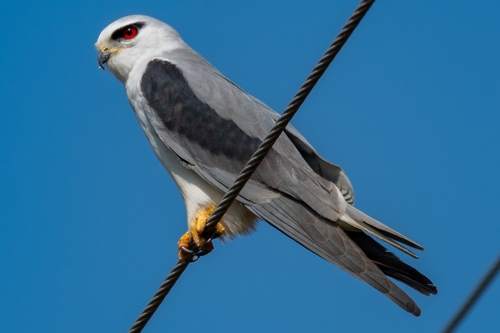
Black-winged Kite
The Black-winged Kite (*Elanus caeruleus*) is a striking bird of prey known for its elegant flight and distinctive plumage. Unlike many raptors that rely on soaring, this species often hovers like a kestrel while hunting. It plays a crucial role in controlling rodent populations, making it beneficial to agricultural areas. Although not globally threatened, certain populations face regional declines due to habitat loss and pesticide use. It holds a certain appeal among birdwatchers due to its graceful appearance and behavior.
31-38 cm
Length
75-90 cm
Wingspan
Least Concern
Conservation Status
Distribution
Found across sub-Saharan Africa, South Asia, Southeast Asia, and parts of Southern Europe (Iberian Peninsula). It has a discontinuous distribution, showing preference for specific habitat types within this broad range. They do not typically undertake long-distance migrations but may move locally in response to food availability.
Lifespan
Unknown in the wild, but likely around 6-8 years based on similar-sized raptors. Can live longer in captivity.
Black-winged Kite's Habitat
Habitat Types
Open grasslands, Savannas, Agricultural lands with scattered trees, Semi-deserts
Climate Zones
Tropical, Subtropical, Temperate
Adaptations
Their preference for open habitats is tied to their hunting style, which requires clear visibility to spot prey from above. Their relatively broad wings and light build facilitate hovering.
Variations
Several subspecies are recognized, differing slightly in size and plumage darkness. For example, *Elanus caeruleus vociferus* is found in South and Southeast Asia, while *Elanus caeruleus caeruleus* is the nominate subspecies found in Europe and Africa.
Appearance
Breeding Plumage
Plumage remains similar year-round.
Seasonal Feather Changes
No significant seasonal variations.
Sex Based Plumage Differences
Males and females have very similar plumage.
Notable Features
Predominantly white underparts, Pale grey upperparts, Distinctive black 'shoulders' (coverts), Red eyes, Short, hooked beak
Diet and Feeding
Primary Foods
Small rodents (voles, mice), Shrews, Large insects (grasshoppers, locusts), Small birds (occasionally)
Foraging Behavior
Hunts primarily by hovering 10-30 meters above the ground, scanning for prey. Once prey is spotted, it descends quickly with a controlled dive. It may also hunt from a perch.
Specializations
Excellent eyesight and the ability to hover are key adaptations for their hunting strategy. Their talons are well-suited for grasping small, fast-moving prey.
Seasonal Diet Variations
Diet may shift slightly depending on prey availability. For instance, they might consume more insects during periods of high insect abundance.
Behavior
Social Structure
Generally solitary or found in pairs. They may form small, loose groups outside of the breeding season, especially in areas with abundant food.
Communication
High-pitched whistles, Kee-kee-kee calls, Used for territorial defense and communication between pairs
Migration
Mostly resident, but some populations may undertake short-distance movements in response to food availability or rainfall patterns. Not considered a long-distance migrant.
Territorial or Group Behaviors
Territorial during the breeding season, defending the area around their nest. Outside of breeding, they can be more tolerant of other individuals.
Conservation
Threats
Habitat loss (conversion of grasslands to intensive agriculture), Pesticide use (reducing prey populations and causing secondary poisoning), Collision with vehicles and power lines, Climate Change
Protection Programs
Some general raptor protection measures benefit this species., Habitat conservation initiatives in some regions.
Local National Laws
Protected under general wildlife laws in many countries within its range.
Population Trend
Stable overall, but some regional declines have been noted.
Population Estimates
Difficult to estimate globally due to its wide and patchy distribution. The global population is thought to be large.
Interesting Facts
They are sometimes called 'Black-shouldered Kites'
This refers to the prominent black markings on their wings, although 'Black-winged Kite' is the more widely accepted name.
They can hunt at dawn and dusk, as well as during the day.
This crepuscular activity allows them to exploit prey that are active during these times.
They have been expanding their range in some areas.
For instance they have been expanding their range in the Europe. This might be due to changes in land use or climate.
Faqs about Black-winged Kite
Are Black-winged Kites dangerous to humans?
No, they are not aggressive towards humans and pose no threat.
What is the difference between a Black-winged Kite and a Black Kite?
Black-winged Kites are smaller and paler, with distinctive black 'shoulders' and red eyes. Black Kites are larger, darker brown, and have a forked tail.
Do Black-winged Kites mate for life?
They are generally monogamous, forming pair bonds that may last for multiple breeding seasons, but long-term studies are needed to confirm lifelong pairing.
Copyright @ Nature Style Limited. All Rights Reserved.
 English
English